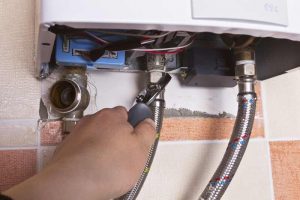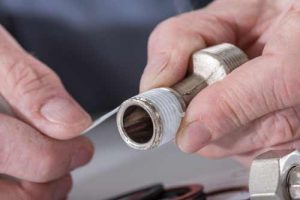Try These 5 Tips for Winter Water Heater Maintenance
As the colder weather arrives in the Wayne area, it’s time to think about those fall home maintenance tasks to get your house ready for the winter. Don’t forget about your water heater on your to-do list.

Getting it winter ready will help keep your energy costs in check and ensure it keeps on providing hot water throughout the winter.
1. Check the Temperature and Pressure Relief Valve
If the temperature or pressure builds up too much inside your tank, it can cause leaks, shorten the life of your heater and even result in an explosion. The temperature and pressure relief (TPR) valve is designed to automatically open and release excess pressure.
 To check it, shut off the water and power supply and place a bucket under the drainpipe connected to the valve. Lift the tab attached to the valve and allow some water to escape, then, close it again. If little or no water comes out when the valve is open, or if water continues to run after it has been closed, you may need to replace the valve.
To check it, shut off the water and power supply and place a bucket under the drainpipe connected to the valve. Lift the tab attached to the valve and allow some water to escape, then, close it again. If little or no water comes out when the valve is open, or if water continues to run after it has been closed, you may need to replace the valve.
2. Inspect the Anode Rod
A magnesium or aluminum rod inside your tank helps to protect it against rust by attracting the corrosive elements in water so that it rusts before the tanks does. To check the rod, with the power and water supply off, unscrew the rod’s hex head located on the top of the tank with a 1 1⁄16-inch socket. Pull the rod out of the tank. If it’s down to ½” in diameter or less, replace it with a new one which can be purchased at most hardware and home improvement stores.
 Wrap the thread with Teflon tape and screw the new rod in place securely.
Wrap the thread with Teflon tape and screw the new rod in place securely.
3. Flush the Tank
Sediment and sand can accumulate at the bottom of the tank, making it more difficult for the system to heat the water and shortening the life of your water heater.
You can flush the tank by attaching a hose to the drain valve located near the bottom of the tank. Place the other end of the hose in a floor drain or somewhere outside. With the water supply turned off and the power shut off or the thermostat set to pilot for gas models, open the drain valve.
Once the tank is empty, briefly turn the water supply back on to stir up the sediment at the bottom and allow it to drain. Repeat the process until the water runs clear.
4. Insulate the Tank
 One of the best ways to reduce your water heating energy costs is to add some insulation to the tank and pipes to prevent heat loss. You can find foil insulating blankets at most home improvements stores.
One of the best ways to reduce your water heating energy costs is to add some insulation to the tank and pipes to prevent heat loss. You can find foil insulating blankets at most home improvements stores.
Cut it to fit around the pipes, valves and thermostat on your heater. Wrap the blanket around the walls of the tank, sealing it using foil tape. The top of gas water heaters should not be covered, but electric models can be capped with an oversized round piece of blanket taped down to the sides of the tank.
5. Adjust the Thermostat
To prevent scalding, we suggest setting the thermostat to 120°F. You can conserve even more energy by maintaining a lower setting. You can save as much as 5% on your energy costs for every 10 degrees difference on your thermostat.
Now, your water heater is all set to take on the colder days of winter in Wayne, NJ. If you don’t feel comfortable taking on the tasks, your friendly experts at PhD Mechanical, Inc. are just a phone call away, (973) 492-5931.


 If you are not 100% satisfied our services, then take advantage of our 1 year guarantee. We are dedicated to providing the absolute best services. Trust the professionals!
If you are not 100% satisfied our services, then take advantage of our 1 year guarantee. We are dedicated to providing the absolute best services. Trust the professionals!